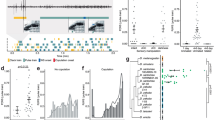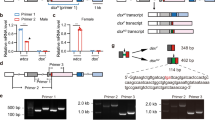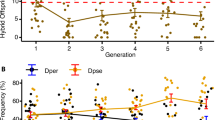Abstract
Recent findings show that traits which influence speciation in the melanogaster subgroup of Drosophila can be determined by relatively few loci and/ or be sex-linked. Using backcrosses between D. simulans and D. mauritiana, we show that an acoustic mating signal which plays an important role in courtship (the interpulse interval of the 'lovesong') has a polygenic determination. There is no evidence of single genes of large effect, a disproportionate contribution of the sex chromosome or epistasis. The probability of finding single genes with a large effect on sexual isolation may vary with the mode of signalling involved.
Similar content being viewed by others
Article PDF
References
Bennet-Clark, H C, and Ewing, A W. 1969. Pulse interval as a critical parameter in the courtship song of Drosophila melanogaster. Anim Behav, 17, 755–759.
Bradshaw, H D, Wilbert, S M, Otto, K G, and Schemske, D W. 1995. Genetic-mapping of floral traits associated with reproductive isolation in Monkeyflowers (Mimulus). Nature, 376, 762–765.
Butlin, R K, and Ritchie, M G. 1993. Behaviour and speciation. In: Slater, P. J. B. and Halliday, T. R. (eds) Behaviour and Evolution, pp. 43–79. Cambridge University Press, Cambridge.
Charlesworth, B, Coyne, J A, and Barton, N H. 1987. The relative rates of evolution of sex chromosomes and autosomes. Am Nat, 130, 113–146.
Cobb, M, and Jallon, J M. 1990. Pheromones, mate recognition and courtship stimulation in the Drosophila melanogaster species subgroup. Anim Behav, 39, 1058–1067.
Cowling, D E, and Burnet, B. 1981. Courtship song and genetic control of their acoustic characteristics in sibling species of the Drosophila melanogaster subgroup. Anim Behav, 29, 924–935.
Coyne, J A. 1992a. Genetics and speciation. Nature, 355, 511–515.
Coyne, J A. 1992b. Genetics of sexual isolation in females of the Drosophila simulans species complex. Genet Res, 60, 25–31.
Coyne, J A, Crittenden, A P, and Mah, K. 1994. Genetics of a pheromonal difference contributing to reproductive isolation in Drosophila. Science, 265, 1461–1464.
Coyne, J A, and Orr, H A. 1989. Two rules of speciation. In: Otte, D. and Endler, J. A. (eds) Speciation and its Consequences, pp. 180–207. Sinauer, Sunderland, MA.
Dobzhansky, T. 1951. Genetics and the Origin of Species, 3rd edn. Columbia University Press, New York.
Ewing, A W. 1969. The genetic basis of sound production in Drosophila pseudoobscura and D. persimilis. Anim Behav, 17, 555–560.
Gorczyca, M, and Hall, J C. 1987. The Insectavox, an integrated device for recording and amplifying courtship songs of Drosophila. Drosoph Inf Serv, 66, 157–160.
Greenacre, M, Ritchie, M G, Byrne, B C, and Kyriacou, C P. 1993. Female song preference and the period gene of Drosophila melanogaster. Behav Genet, 23, 85–90.
Haldane, J B S. 1922. Sex-ratio and unisexual sterility in hybrid animals. J Genet, 12, 101–109.
Henry, C S. 1994. Singing and cryptic speciation in insects. Trends Ecol Evol, 9, 388–392.
Jallon, J M. 1987. Variations in cuticular hydrocarbons among the eight species of the Drosophila melanogaster subgroup. Evolution, 41, 294–302.
Kyriacou, C P, and Hall, J C. 1982. The function of courtship song rhythms in Drosophila. Anim Behav, 30, 794–801.
Kyriacou, C P, and Hall, J C. 1986. Interspecific genetic control of courtship song production and reception in Drosophila. Science, 232, 494–497.
Lemeunier, F, David, J R, Tsacas, L, and Ashburner, M. 1986. The melanogaster species group. In: Ashburner, M., Carson, H. L. and Thompson, J. J. N. (eds) The Genetics and Biology of Drosophila, vol. 3e, pp. 147–256. Academic Press, London.
Löfstedt, C. 1993. Moth pheromone genetics and evolution. Phil Trans R Soc B, 340, 167–177.
Löfstedt, C, Hansson, B S, Roelofs, W, and Bengtsson, B O. 1989. No linkage between genes controlling female pheromone production and male pheromone response in the European corn borer, Ostrinia nubilalis Hübner (Lepidoptera; Pyralidae). Genetics, 123, 553–556.
Majerus, M E N, O'Donald, P, Kearns, P W E, and Ireland, H. 1986. Genetics and the evolution of female choice. Nature, 321, 164–167.
Mayr, E. 1963. Animal Species and Evolution. Harvard University Press, Cambridge, MA.
Mitchell-Olds, T. 1995. The molecular basis of quantitative genetic variation in natural populations. Trends Ecol Evol, 10, 324–328.
Orr, H A. 1993. Haldane's rule has multiple genetic causes. Nature, 361, 532–533.
Orr, H A, and Coyne, J A. 1992. The genetics of adaptation: a reassessment. Am Nat, 140, 725–742.
Paterson, H E H. 1993. Evolution and the Recognition Concept of Species. Johns Hopkins University Press, Baltimore.
Reinhold, K. 1994. Inheritance of body and testis size in the bushcricket Poecilimon veluchianus Ramme (Orthoptera; Tettigoniidae) examined by means of subspecies hybrids. Biol J Linn Soc, 52, 305–316.
Ritchie, M G, and Kyriacou, C P. 1994. The genetic variability of courtship song in a population of Drosophila melanogaster. Anim Behav, 45, 425–434.
Ritchie, M G, Yate, V H, and Kyriacou, C P. 1994. Genetic variability of the interpulse interval of courtship song among some European populations of Drosophila melanogaster. Heredity, 72, 459–464.
Scott, D. 1994. Genetic variation for female mate discrimination in Drosophila melanogaster. Evolution, 48, 112–121.
Stratton, G E, and Uetz, G W. 1986. The inheritence of courtship behavior and its role as a reproductive isolating mechanism in two species of Schizocosa wolf spiders (Araneae: Lycosidae). Evolution, 40, 129–141.
Tomaru, M, and Oguma, Y. 1994a. Genetic basis and evolution of species-specific courtship song in the Drosophila auraria complex. Genet Res, 63, 11–17.
Tomaru, M, and Oguma, Y. 1994b. Differences in courtship song in the species of the Drosophila auraria complex. Anim Behav, 47, 133–140.
Tomaru, M, Matsubayashi, H, and Oguma, Y. 1995. Heterospecific inter-pulse intervals of coursthip song elicit female rejection in Drosophila biauraria. Anim Behav, 50, 905–914.
Van Den Berg, M J. 1988. Assortative Mating in Drosophila melanogaster and Among Three Species of the melanogaster Subgroup. Ph.D. Thesis, University of Groningen, The Netherlands.
Wheeler, D A, Kyriacou, C P, Greenacre, M L, Yu, Q, Rutila, J E, Rosbash, M, and Hall, J C. 1991. Molecular transfer of a species-specific behavior from Drosophila simulans to Drosophila melanogaster. Science, 251, 1082–1085.
Acknowledgements
Acknowledgements We thank Prof. J. David and Dr C. P. Kyriacou for kindly supplying some of the stocks used. This research was funded by the SERC/BBSRC (studentship 93309713 to A.P.) and NERC (Fellowship GT5/92/TLS/16 to M.G.R.). The manuscript was improved following helpful comments from referees.
Author information
Authors and Affiliations
Rights and permissions
About this article
Cite this article
R G Pugh, A., Ritchie, M. Polygenic control of a mating signal in Drosophila. Heredity 77, 378–382 (1996). https://doi.org/10.1038/hdy.1996.156
Received:
Issue date:
DOI: https://doi.org/10.1038/hdy.1996.156
Keywords
This article is cited by
-
The genetic architecture of insect courtship behavior and premating isolation
Heredity (2009)
-
Genetics of divergence in male wing pigmentation and courtship behavior between Drosophila elegans and D. gunungcola
Heredity (2006)
-
Mutations and Natural Genetic Variation in the Courtship Song of Drosophila
Behavior Genetics (2005)
-
QTL analysis of variation in male courtship song characters in Drosophila virilis
Heredity (2004)



